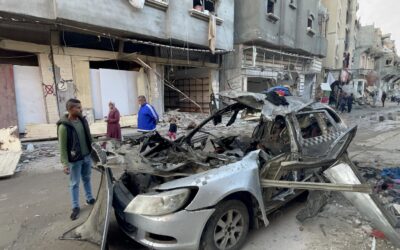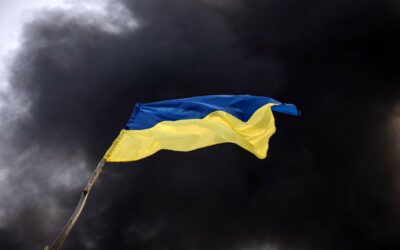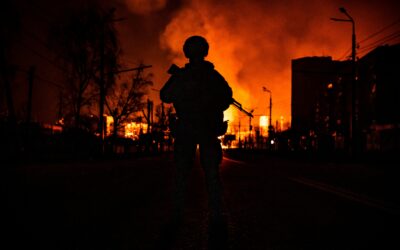
In Future Wars, Drone Weapons With Minds of Their Own
SUBSCRIBER+EXCLUSIVE BRIEFING — Drone weapons are part of the daily narrative of the war in Ukraine – from Russia’s use of Iranian drones against infrastructure […] More
OPINION — Last week, aircraft and personnel from 14 NATO countries carried out the annual exercise, code-named Steadfast Noon, which involved practicing nuclear strike missions with dual-capable aircraft and unarmed, American-made B61 tactical nuclear bombs, similar to the roughly 150 B61s the U.S. currently has on bases in five European countries.
According to a NATO statement on the exercise, “No live weapons are used. This exercise helps to ensure that NATO’s nuclear deterrent remains safe, secure and effective.”
No scenario was given for what led to a U.S. President authorizing the apparent use of such devastating weapons in last week’s exercise, and that fact alone encouraged me to go back into records to try to show again how doubtful it would be for any such Presidential order to occur.
In this case, I went to the amazing set of Presidential Oral Histories compiled by the Miller Center at the University of Virginia that contain revealing interviews with personnel from the past administrations of Presidents Jimmy Carter, Ronald Reagan, George H. W. Bush, William J. Clinton and George W. Bush.
I focused on the President George H. W. Bush administration with Dick Cheney, when he was Secretary of Defense, and the late Colin Powell, when he was Chairman of the Joint Chiefs. Here is what they said when the issue of possibly using U.S. tactical nuclear weapons came up in late 1990 as the U.S. was preparing Operation Desert Storm to push Saddam Hussein’s Iraqi troops out of Kuwait.
As Cheney put it when questioned at the Miller Center in March 2000, “If he [Saddam] uses biological or chemical agents against our troops, all bets are off and we reserve the right to use any means at our disposal to respond…The threat clearly was that we’d use, or threaten to use, nuclear weapons.”
The Cipher Brief hosts private briefings with the world’s most experienced national and global security experts. Become a member today.
Cheney went on, “I asked for—and had to ask a number of times—for there to be some planning done in the Joint Staff about how we would react if in fact, that happened. I said, I want to know how many tactical nuclear weapons will it take to destroy a division of the Iraqi Republican Guard. Here’s your divisions laid out there. You come back and tell me how many nukes.”
As for President Bush, who would have had to order their use, Cheney said, “He [Bush] would have been aware that this was a problem, as I say, without question, but I don’t recall a conversation with him. The nuclear, tactical nuclear weapons option was something I wanted. I wanted to know myself, if something happened, is this an option? What do you do to them? So as I say, I found out it takes 17 weapons to destroy an Iraqi Republican Guard division. Or at least that is what I was told.”
Cheney said he had “read the history of the Eisenhower years and we’re trying to build nuclear weapons, and Hiroshima and Nagasaki aren’t that far in the past. We’d used them. By the time you get to the 1990s it is not a very realistic option from the standpoint of the U.S. military.”
The Cold War scenario had been “we might have to resort to nuclear weapons to stop—and reserved the right to do so—to stop a Soviet invasion of Western Europe,” Cheney said, but then he added, “We had problems with some of those weapons; we had to redeploy them. I think there was always doubt, at least in some of our minds, about an 8-inch nuclear round that you are going to launch out of some artillery piece over here and hit a target 10 or 12 miles away, if that was what you were doing. Didn’t seem to be necessarily the right thing to do if you didn’t have to.”
As for Joint Chiefs Chairman Powell, Cheney said, “Colin had strong feelings, Powell did, about tactical nuclear weapons. He didn’t like them. Maybe it was his European experience…He was not a big fan of tactical nukes. I think part of that was based on his earlier experiences in the service. But that was, I would say, the dominant thinking in the U.S. Army especially, and the military.”
I, myself, know that to have been true, having written about the neutron warhead in 1977. I studied nuclear weapons thereafter and can say the Army disliked the thought of using tactical nuclear weapons because no one knew what would happen after the first one was used.
Go beyond the headlines with expert perspectives on today’s news with The Cipher Brief’s Daily Open-Source Podcast. Listen here or wherever you listen to podcasts.
When Powell, himself, was interviewed in 2011 for the Miller Center collection, he looked back to the 1990s and said, “The Army did not need to have nuclear weapons. We could make the rubble bounce everywhere now. I was pushing Secretary Cheney to eliminate nuclear weapons in the Army. The Marine Corps was already getting rid of them and some of the Air Force weapons and all of the tactical nuclear weapons aboard the ships.”
In fact, in advance of President George H. W. Bush’s doing away with most deployed U.S. tactical nuclear weapons in September 1991, Powell recalled, “We sat at the President’s desk one afternoon and I said, Mr. President, I’ve talked to the Chiefs, and they all agree with this…even the Chief of Staff of the Army agrees—surprise, surprise. In ten minutes, he approved the elimination of all of our tactical nuclear weapons, except for the number we kept in the Air Force for fighter-bomber delivery.”
In a broader sense, Powell said, “Nukes are of course a weapon of mass destruction, but I can list as many countries that have given them up as those who have tried to pursue them…South Africa gave it up. Even Libya gave it up, and Chile. They all abandoned it. And Iran and North Korea. They can’t be used. It would be suicidal.”
In his Miller Center 2000 interview — and remember this was before the 2003 Iraq invasion when Cheney was Vice President – Cheney recalled during 1990 he had ordered a review of the SIOP, the Single Integrated Operational Plan that provides target options for a U.S. President in the event strategic nuclear weapons are to be used.
Cheney found, as he said back in March 2000, “The number of weapons [in the SIOP plan back then] that were actually going down in a particular geographic area, it didn’t make a hell of a lot of sense, frankly. It was clear that there were places where there were one hell of a lot of weapons going down because we just added stuff over the years and had never really gone back and looked at it in those terms.”
As a result, he said, “We concluded…we had a lot more nuclear warheads than we needed. That we could cover the target base and do what needed to be done with fewer weapons…We wanted to preserve the Triad [nuclear delivery by submarines, bombers and land-based ICBMs]…But it also offered up the opportunity to put stuff on the table in the course of strategic arms control talks, because now we had something to trade away.”
In fact, Cheney’s 1991 SIOP study became the basis for Bush’s radical arms control reduction proposals to Russia’s Mikhail Gorbachev in September 1991.
Other parts of Cheney’s 2000 interview are even pertinent today as the Biden administration is preparing its own Nuclear Posture Review, due in the next few months.
For example, Cheney said, “I’m just trying to recreate in my own mind some of my thinking. In a whole other part of the DoD arena, cruise missile technology, we had developed the capability—with standoff conventional weapons, which we demonstrated conclusively in Iraq [meaning Operation Desert Storm]—that we can go in and hit key nodes and shut down a country, take down the power grid, shut down their transportation system, their telecommunication system, whatever it meant. It meant pinpoint strikes with accurate weapons, but a conventional warhead [emphasis added]. You give me a few cruise missiles, I can shut down any country in the world for a period of time.”
In short, Cheney in 2000 recognized that some, if not many, targets programmed for nuclear weapons could be hit by precision conventional weapons.
I would say almost all could be hit with precision conventional weapons or even taken down with cyber weapons. It’s time to see nuclear weapons for what they are – and were back in 1945 – terror weapons to end a war, not to fight one.
Another issue being considered for the Biden Nuclear Posture review is a proposal for the U.S. to adopt a “no first use” policy for its nuclear weapons. The Trump Administration, in the 2018 Nuclear Posture Review, rejected that idea and stated that “the United States would only consider the employment of nuclear weapons in extreme circumstances to defend the vital interests of the United States, its allies, and partners.”
Again, I turn to the Miller Center oral histories, this time to James Baker’s interview in March 2011 when he talked about his time as Secretary of State in the days before Operation Desert Storm. Baker recalled that before he met with Saddam Hussein’s closest advisor, Tariq Aziz in January 1991, the Defense Department, meaning Cheney, told him, Baker, “that if they use weapons of mass destruction on our troops, we would respond,” meaning use nuclear weapons.
Baker continued, “And so what I said to the Minister [Aziz] was, Minister, if you use weapons of mass destruction on our forces, the American people will demand revenge, and we have the means to exact it. Then I said, ‘That is not a threat, it is a promise.’ So, after they captured Saddam and debriefed him, they said, ‘Why didn’t you use your chemical weapons when the Americans were coming?’ And he implied—maybe he didn’t say this in so many words, but implied—it was because of what Baker told Aziz at Geneva. So, it [the nuclear threat] was effective.”
Baker said, “Based on this real-time example of how such a threat really worked to protect our troops,” the Obama 2010 Nuclear Posture Review made a mistake when it said it would only use conventional weapons against a non-nuclear state that employed chemical or biological weapons.
Thus, although the NATO exercise last week tested whether the U.S. and its allies were prepared to use tactical nuclear weapons, it’s doubtful any real order to do so will ever occur.
On the other hand, as long as the threat to use nuclear weapons exists, such exercises could, as they have done in the past, help avoid lesser military conflicts between countries that possess them or other weapons of mass destruction.
Read more expert-driven national security news, insights and perspective in The Cipher Brief
Related Articles

SUBSCRIBER+EXCLUSIVE BRIEFING — Drone weapons are part of the daily narrative of the war in Ukraine – from Russia’s use of Iranian drones against infrastructure […] More

SUBSCRIBER+ EXCLUSIVE ANALYSIS — Iran’s retaliatory strikes against Israel this weekend were both a potentially game-changing, historic first — and an underwhelming response. Historic, because […] More

SUBSCRIBER+EXCLUSIVE INTERVIEW — Ukraine was hit by a fresh round of Russian missile attacks on Thursday, strikes that targeted and damaged the country’s power grid […] More

SUBSCRIBER+ EXCLUSIVE REPORTING — The Israeli drone strike that killed three adult sons (who Israel says were Hamas operatives) and four grandchildren of Hamas’s Qatar-based […] More

BOTTOM LINE UP FRONT – In the spring of 2022, Ukraine beat back a Russian assault on the nation’s capital and punished the invaders on […] More

SUBSCRIBER+EXCLUSIVE — The Ukraine war has reached a “pivotal moment,” a “critical stage,” an “inflection point“ – all phrases used to describe the current situation […] More
Search